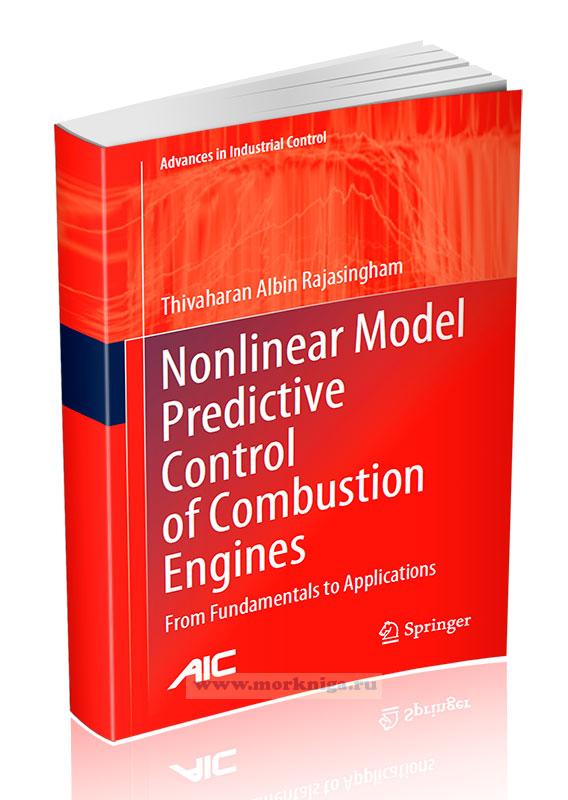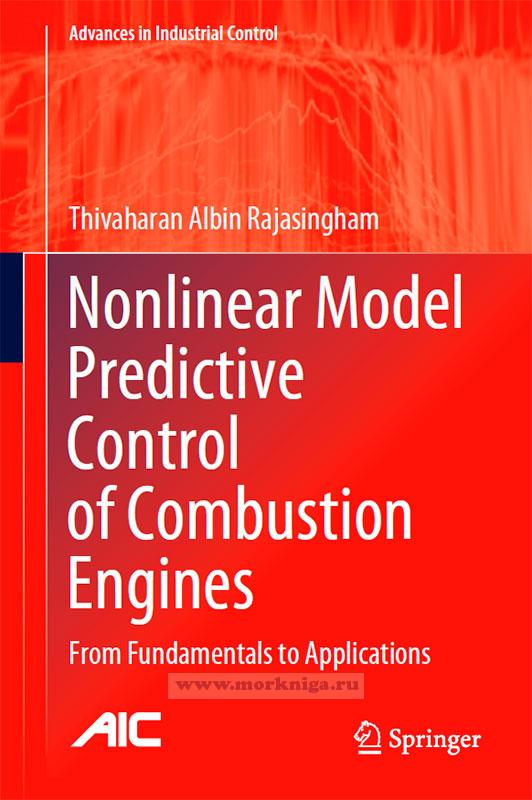Nonlinear Model Predictive Control of Combustion Engines/Проблемы управления двигателем внутреннего сгорания
Книга на английском языке.
This book covers a wide range of combustion engine control problems from innovative airpath concepts to new combustion concepts. Provides readers with a systematic insight into the modeling and optimization-based control of complex combustion engine systems. Explains application examples in detail, which have been successfully implemented on real-world combustion engines and real-world vehicles tested on public roads.
Contents
1 Introduction
1.1 Motivation to Improve Engine Performance
1.2 Improving the Engine Performance by Advanced Control
1.3 Control Algorithms for Engine Control
1.4 Introduction to Model Predictive Control
1.4.1 Formulation of the Optimization Problem
1.4.2 Control-OrientedModeling
1.4.3 Numerical Optimization
1.5 Aims and Outline of the Book
References
2 Model-Based Approach with PID Controllers
2.1 Multiple-Input Multiple-Output Systems
2.1.1 Introduction to MIMO Systems
2.1.2 Relative Gain Array
2.1.3 System Decoupling
2.2 Actuator Constraints
2.2.1 Integrator Windup
2.2.2 Directionality in Constrained MIMO Systems
2.3 Control Approach Based on Look-Up Tables
References
3 Mathematical Fundamentals of Optimization
3.1 Introduction to Optimization Problems
3.2 Convex Optimization Problems
3.3 Classes of Optimization Problems
3.3.1 Dynamic Optimization
3.3.2 Static Optimization
3.4 Optimality Conditions for NLPs
3.4.1 Unconstrained Optimization Problems
3.4.2 Constrained Case: Equality Constraints
3.4.3 Constrained Case: Inequality and Equality Constraints
3.4.4 Graphical Interpretation
References
Part I Model Predictive Control
4 Linear Model Predictive Control
4.1 Linear Model Representation
4.1.1 Discrete-Time State-Space Model for Linear Systems
4.1.2 Discretization of Linear Continuous-Time State-Space Models
4.2 Cost Function for Linear MPC
4.3 Unconstrained Linear MPC
4.3.1 Analytic Solution of the Optimization Problem
4.3.2 Resulting Control Law
4.4 Constrained Linear MPC
4.4.1 Dense Formulation
4.4.2 Sparse Formulation
4.4.3 Comparison of Dense and Sparse Formulations
4.4.4 Control Structure of Constrained Linear MPC
4.4.5 Numerical Solution of the Resulting Quadratic Program
4.5 Linear Time-Variant (LTV) Model Predictive Control
4.6 Numerical Examples for Linear MPC
References
5 Nonlinear Model Predictive Control
5.1 Introduction to Nonlinear MPC
5.2 Numerical Solution of the Resulting Nonlinear Program
5.2.1 Solving the Unconstrained NLP
5.2.2 Solving the Constrained NLP via Sequential Quadratic Programming
5.2.3 Approximation of HessianMatrix
5.3 Discretization of the OCP via Shooting Methods
5.3.1 Numerical Methods for Simulation
5.3.2 Discretization of Actuated Values, Cost Function, and Constraints
5.3.3 Discretization via Single Shooting
5.3.4 Discretization via Multiple Shooting
5.3.5 Real-Time NMPC
References
6 Formulation of the Optimization Problem
6.1 Soft Constraints
6.2 Offset-Free Control
6.2.1 Observer-Based Offset-Free Control
6.2.2 Offset-Free Control Using a Deadbeat Observer
6.3 Reference Tracking
6.3.1 Delta Formulation
6.3.2 Two-Layered Control Structure
6.4 Stability Mechanisms
6.4.1 Stability of the Infinite-Horizon MPC
6.4.2 Stability of Finite-Horizon MPC
References
Part II Introduction to Combustion Engine Control
7 SI and CI Engine Control Architectures
7.1 Overview of Engine Control Tasks
7.2 SI Engine Control Systems
7.2.1 Air Path Controller
7.2.2 Fuel Path Controller
7.2.3 Ignition Path Controller
7.2.4 Control Structure
7.3 CI Engine Control
7.3.1 Fuel Path Controller
7.3.2 Air Path Controller
7.3.3 Aftertreatment Path Controller
7.3.4 Control Structure
References
8 Low-Temperature Combustion Engine Control
8.1 Introduction to LTC Engines
8.2 Gasoline-Based LTC: Gasoline Controlled Autoignition
8.2.1 Cycle-to-Cycle-Based Control Strategies
8.2.2 Multi-scale Control Strategies
8.3 Diesel-Based LTC: Premixed Charge Compression Ignition
8.4 Dual-Fuel-Based LTC: Reactivity Controlled Compression Ignition
References
Part III In-Depth Case Studies: Combustion Control
9 Fundamentals of Control-Oriented Air Path Modeling
9.1 Introduction to Control-Oriented Air Path Modeling
9.1.1 Requirements on Control-Oriented Air Path Models
9.1.2 Continuous Differentiability
9.2 Volume
9.3 Engine
9.4 Flow Restriction Model
9.4.1 Incompressible Flow Restriction Model
9.4.2 Compressible Flow Restriction Model
9.5 Turbocharger
9.5.1 Compressor
9.5.2 Turbine
9.5.3 Turbocharger Dynamics
References
10 Combined Exhaust Gas Recirculation and VTG: Modeling and Analysis
10.1 System Setup
10.2 Control-Oriented Process Model
10.3 Validation of the Process Model
10.4 Analysis of the System Dynamics
10.4.1 Nonlinearity
10.4.2 Pole-Zero Locations
10.4.3 Relative Gain Array
References
11 Combined Exhaust Gas Recirculation and VTG: Control
11.1 Nonlinear MPC Algorithm
11.1.1 Controller-Internal Model
11.1.2 Formulation of the Optimization Problem
11.1.3 Parametrization of the Numerical Solver
11.1.4 Parametrization of the Cost Function
11.2 Model-Based Synthesis of PI Controllers
11.2.1 Decentralized Synthesis of PI Controllers
11.2.2 Decoupling Control Approach
11.2.3 Anti-windup and Dead-Time
11.3 Simulative Comparison of the Controllers
11.4 Experimental Validation
References
12 Two-Stage Turbocharging: Modeling and Analysis
12.1 Introduction
12.2 System Setup
12.2.1 Sensors
12.2.2 Actuators
12.2.3 Engine Control Algorithm
12.3 Nonlinear Process Model for Two-Stage Turbocharging
12.3.1 Fundamental Equations of Two-Stage Turbocharging
12.3.2 Overall State-Space Model
12.4 Analysis of the System Dynamics
12.4.1 Stationary System Behavior
12.4.2 Transient System Behavior
12.5 Validation of Reduced-Order Model
References
13 Two-Stage Turbocharging: Control
13.1 Nonlinear MPC Algorithm
13.1.1 Controller-Internal Model
13.1.2 Formulation of the Optimization Problem
13.1.3 Numerical Solution of the Optimization Problem
13.2 Validation of the NMPC Algorithm by Simulations
13.3 Experimental In-Vehicle Validation of the NMPC Algorithm
References
Part IV In-Depth Case Studies: Combustion
14 Fundamentals of CI Engine Combustion Control and Modeling
14.1 Introduction to Combustion Control
14.2 Control-Oriented Process Model
14.2.1 Mass Balance
14.2.2 Energy Balance
14.2.3 Applications of the Single-Zone Model
14.2.4 Combustion Chamber Volume
14.2.5 Heat Transfer Through Combustion Chamber Walls
14.3 Control of Cycle-Integral Combustion Parameters
14.4 Combustion Rate Shaping
References
15 Combustion Rate Shaping Control
15.1 Introduction
15.2 CombustionModeling
15.2.1 Overview on Combustion Modeling Approaches
15.2.2 Data-Based Combustion Models
15.3 Optimization-Based Fuel Injection Rate Digitalization
15.3.1 Data-Based Fuel Injection Model
15.3.2 Formulation of the Optimization Problem
15.3.3 Validation of the Fuel Injection Rate Digitalization Concept
References
Index

